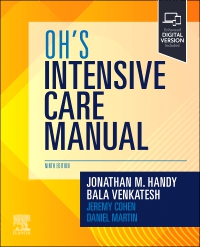
Oh's Intensive Care Manual, 9th Edition
Paperback

$125.99
-
- Balances information on management and treatment of conditions with essential pathophysiological and pharmacological background—all with an increased focus on clinical management strategies to optimise patient outcomes
- Offers authoritative treatment guidelines covering both adult and paediatric patients in the ICU
- Discusses the latest developments in such areas as ARDS, sepsis, neurological disorders, and morbid obesity
- Provides an increased number of summary boxes, tables, and charts to facilitate quick retrieval of essential information
- Contains new sections on Decision Making, Special Populations, The Post-Operative Patient, and more.
- Includes numerous new chapters: Allied health professionals in ICU; Clinical assessment of the critically ill patient; Determination of death in ICU; Mechanical cardiac supports; Acute aortic syndrome; Overview of respiratory failure in ICU; COVID-19; Neuromonitoring; Pre-operative assessment of high risk patient; Post-operative thoracic surgical patient; Post-operative neuro-surgical patient; Principles of organ procurement and donation; and more
- Shares the knowledge and global expertise of a “who’s who” of international specialist ICU Consultants, including new editor Professor Bala Venkatesh, Universities of Queensland and New South Wales, Australia
- Provides an extensive list of important, up-to-date references
- An eBook version is included with purchase. The eBook allows you to access all of the text, figures, and references, with the ability to search, customize your content, make notes and highlights, and have content read aloud. Additional digital ancillary content may publish up to 6 weeks following the publication date
-
Part One - Structure and Process
1 Design and organisation of intensive care units
2 Rapid response systems: care of critically ill patients outside of critical care
3 Critical care nursing
4 Allied health professionals in ICU
5 Team-based healthcare delivery
6 Pandemic and major incident planning
7 Transport of critically ill patients
8 Common problems after ICU
Part Two - Decision Making
9 Clinical assessment of the critically ill patient
10 Severity scoring and outcome prediction
11 Trials
12 Ethics
13 Treatment limitation and palliative care
14 The determination of death in ICU
Part Three - Sepsis and Infections Requiring ICU Support
15 Sepsis and septic shock
16 Multi-organ dysfunction syndrome
17 Genetics in sepsis
18 Healthcare-associated infection
19 Fungal infection
20 Principles of antimicrobial use in the intensive care unit
21 Tropical infections
22 Severe soft-tissue infections
Part Four - Cardiovascular Intensive Care
23 Overview of shock
24 Haemodynamic monitoring
25 Echocardiography in intensive care
26 Inotropes and vasopressors (vasoactive drugs)
27 Vasodilators and antihypertensives
28 Mechanical cardiac supports
29 Acute coronary syndromes, investigations and interventions
30 Cardiopulmonary resuscitation (including defibrillation)
31 Cardiac arrhythmias
32 Cardiac pacing
33 Acute heart failure and pulmonary hypertension
34 Valvular and congenital heart disease and infective endocarditis
35 Acute aortic syndrome
Part Five - Respiratory Failure
36 Overview of respiratory failure in ICU
37 Acute respiratory distress syndrome
38 Respiratory monitoring
39 Troubleshooting mechanical ventilation waveforms
40 Chest imaging and ultrasound in the ICU
41 Oxygen therapy, humidifiers and inhalation therapy
42 Mechanical ventilator support
43 Non-invasive ventilation
44 Airway management and acute airway obstruction
45 Pulmonary embolism
46 Acute severe asthma
47 Acute respiratory failure in chronic obstructive pulmonary disease
48 Pneumonia
49 COVID-19
50 Extracorporeal membrane oxygenation for respiratory failure
Part Six - Gastroenterological Emergencies and Surgery
51 Enteral and parenteral nutrition
52 Acute gastrointestinal bleeding
53 Acute pancreatitis
54 Hepatic failure
Part Seven - Acute Renal Failure
55 Acute kidney injury
56 Renal replacement therapy
57 Acid-base disorders and hyperlactataemia
58 Fluid and electrolyte therapy
Part Eight - Neurological Disorders
59 Disorders of consciousness
60 Cerebral protection
61 Status epilepticus
62 Acute cerebrovascular complications
63 Meningitis and encephalomyelitis
64 Neuromonitoring
65 Delirium
66 ICU-acquired weakness
67 Neuromuscular disorders
Part Nine - Endocrine Disorders
68 Diabetic emergencies and glucose control in the ICU
69 Polyuria in the ICU – diabetes insipidus and other causes
70 Thyroid emergencies
71 Adrenocortical insufficiency in critical illness
Part Ten - Surgical Patient
72 Preoperative assessment of the high-risk patient
73 Postoperative cardiac intensive care
74 Post-operative thoracic surgical patient
75 Management of the post-operative neurosurgical patient
76 Postoperative care after major abdominal operations
Part Eleven - Severe and Multiple Trauma
77 Severe and multiple injuries
78 Severe head injuries
79 Maxillofacial and upper-airway injuries
80 Chest injuries
81 Spinal injuries
82 Abdominal and pelvic injuries
Part Twelve - Special Populations
83 Intensive care and the elderly
84 Obesity
85 The immunocompromised host
86 Implications of solid tumours for intensive care
87 Māori, Aboriginal and Torres Strait Islander populations and critical illness: an overview
88 Pre-eclampsia, eclampsia and related disorders in pregnancy
89 Obstetric emergencies
Part Thirteen - The Paediatric Patient
90 The critically ill child
91 Upper airway obstruction in children
92 Acute respiratory distress in children
93 Paediatric fluid and electrolyte therapy
94 Sedation and analgesia in children
95 Shock and cardiac disease in children
96 Neurological emergencies in children
97 Paediatric trauma
98 Paediatric treatment limitation and organ donation
99 Paediatric poisoning and envenomation
100 Paediatric cardiopulmonary resuscitation
Part Fourteen - Environmental Injuries
101 Poisoning and drug intoxication
102 Submersion
103 Burns
104 Thermal disorders
105 Electrical safety and injuries
106 Envenomation
107 Blast and ballistic trauma
108 Chemical, biological, radiological and nuclear exposure management
Part Fifteen - Inflammatory and Immune Disorders
109 Anaphylaxis
110 Therapeutic plasma exchange and intravenous immunoglobulin therapy
111 Rheumatology
Part Sixteen - Haematological Management
112 Blood transfusion and patient blood management
113 Haemostatic failure
114 Haematological malignancy
Part Seventeen - Transplantation
115 Organ donation
116 Liver and kidney transplantation
117 Heart transplantation
118 Lung transplantation
Part Eighteen - Pharmacologic Considerations
119 Pharmacokinetics, pharmacodynamics and drug monitoring in acute illness
120 Sedation and pain management in intensive care

 as described in our
as described in our 